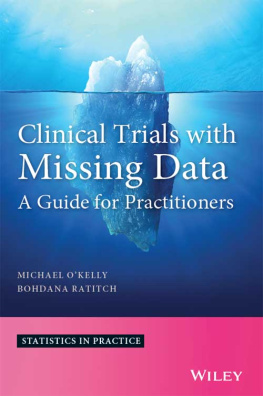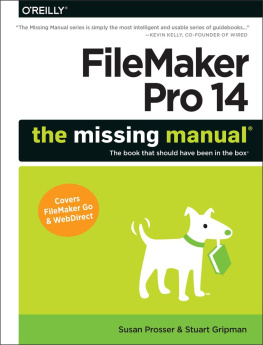STATISTICS IN PRACTICE
Series Advisors
Human and Biological Sciences
Stephen Senn
CRP-Sant, Luxembourg
Earth and Environmental Sciences
Marian Scott
University of Glasgow, UK
Industry, Commerce and Finance
Wolfgang Jank
University of Maryland, USA
Founding Editor
Vic Barnett
Nottingham Trent University, UK
Statistics in Practice is an important international series of texts which provide detailed coverage of statistical concepts, methods and worked case studies in specific fields of investigation and study.
With sound motivation and many worked practical examples, the books show in down-to-earth terms how to select and use an appropriate range of statistical techniques in a particular practical field within each titles special topic area.
The books provide statistical support for professionals and research workers across a rangeof employment fields and research environments. Subject areas covered include medicine andpharmaceutics; industry, finance and commerce; public services; the earth and environmentalsciences, and so on.
The books also provide support to students studying statistical courses applied to the above areas. The demand for graduates to be equipped for the work environment has led to such courses becoming increasingly prevalent at universities and colleges. It is our aim to present judiciously chosen and well-written workbooks to meet everyday practical needs. Feedback of views from readers will be most valuable to monitor the success of this aim.
A complete list of titles in this series appears at the end of the volume.
This edition first published 2014
2014 John Wiley & Sons, Ltd
Registered office
John Wiley & Sons Ltd, The Atrium, Southern Gate, Chichester, West Sussex, PO19 8SQ, United Kingdom
For details of our global editorial offices, for customer services and for information about how to apply for permission to reuse the copyright material in this book please see our website at www.wiley.com .
The right of the author to be identified as the author of this work has been asserted in accordance with the Copyright, Designs and Patents Act 1988.
All rights reserved. No part of this publication may be reproduced, stored in a retrieval system, or transmitted, in any form or by any means, electronic, mechanical, photocopying, recording or otherwise, except as permitted by the UK Copyright, Designs and Patents Act 1988, without the prior permission of the publisher.
Wiley also publishes its books in a variety of electronic formats. Some content that appears in print may not be available in electronic books.
Designations used by companies to distinguish their products are often claimed as trademarks. All brand names and product names used in this book are trade names, service marks, trademarks or registered trademarks of their respective owners. The publisher is not associated with any product or vendor mentioned in this book.
Limit of Liability/Disclaimer of Warranty: While the publisher and author have used their best efforts in preparing this book, they make no representations or warranties with respect to the accuracy or completeness of the contents of this book and specifically disclaim any implied warranties of merchantability or fitness for a particular purpose. It is sold on the understanding that the publisher is not engaged in rendering professional services and neither the publisher nor the author shall be liable for damages arising herefrom. If professional advice or other expert assistance is required, the services of a competent professional should be sought.
Library of Congress Cataloging-in-Publication Data
OKelly, Michael, author.
Clinical trials with missing data : a guide for practitioners / Michael OKelly, Bohdana Ratitch.
p. ; cm. (Statistics in practice)
Includes bibliographical references and index.
ISBN 978-1-118-46070-2 (hardback)
I. Ratitch, Bohdana, author. II. Title. III. Series: Statistics in practice.
[DNLM: 1. Clinical Trials as Topic. 2. Bias (Epidemiology) 3. Models, Statistical. 4. Research Design. QV 771.4]
R853.C55
610.724dc23
2013041088
A catalogue record for this book is available from the British Library.
ISBN: 978-1-118-46070-2
To Raymond Kearns, teacher and Linda ONolan, partner.
Michael OKelly
To my family, with love and gratitude for inspiration and support.
Bohdana Ratitch
Preface
The aim of this book is to explain the difficulties that arise with the credibility and interpretability of clinical study results when there is missing data; and to provide practical strategies to deal with these difficulties. We try to do this in straightforward language, using realistic clinical trial examples.
This book is written to serve the needs of a broad audience of pharmaceutical industry professionals and regulators, including statisticians and non-statisticians, as well as academics with an interest in or need to understand the practical side of handling missing data. This book could also be used for a practical course in methods for handling missing data. For statisticians, this book provides mathematical background for a wide spectrum of statistical methodologies that are currently recommended to deal with missing data, avoiding unnecessary complexity. We also present a variety of examples and discussions on how these methods can be implemented using mainstream statistical software. The book includes a framework in which the entire clinical study team can contribute to a sound design of a strategy to deal with missing data, from prevention, to formulating clinically plausible assumptions about unobserved data, to statistical analysis and interpretation.
In the past, missing data was sometimes viewed as a problem that can be taken care of within statistical methodology without burdening others with the technicalities of it. While it is true that sophisticated statistical methods can and should be used to conduct sound analyses in the presence of missing data, all these methods make assumptions about missing data that clinical experts should help to formulate assumptions that should be clinically interpretable and plausible. Moreover, it is important to understand that some assumptions about missing data are always being made, be it explicitly or implicitly. Even a strategy using only observed data for analysis carries within it certain implicit assumptions about subjects with missing data, and these assumptions are being implicitly made part of study conclusions. Clinicians fully participate in the effort to select carefully the type of data (clinical endpoints) that could best serve as evidence for efficacy and safety of a treatment. Their clinical expertise is invaluable for the choice of data that is collected in a clinical trial and subsequently used as observed data. Similarly, it is only natural to expect that the same level of clinical expertise would be provided to make choices for hidden data the assumptions that would be used in place of missing data as an integral part of the overall body of evidence. Parts of this book (Chapters 14) contain non-technical material that can be easily understood by non-statisticians, and we hope that it will help clinicians and statisticians to build a common ground and a common language in order to tackle appropriately the problem of missing data together. Chapter 2 is dedicated entirely to prevention of missing data, which is the best way to deal with the problem, albeit not sufficient by itself in reality. Everyone involved in the planning and conduct of clinical trials would benefit from the ideas presented in this chapter.









